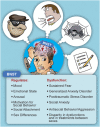Overshadowed by the amygdala: the bed nucleus of the stria terminalis emerges as key to psychiatric disorders
- PMID: 26878891
- PMCID: PMC4804181
- DOI: 10.1038/mp.2016.1
Overshadowed by the amygdala: the bed nucleus of the stria terminalis emerges as key to psychiatric disorders
Erratum in
-
Correction: Overshadowed by the amygdala: the bed nucleus of the stria terminalis emerges as key to psychiatric disorders.Mol Psychiatry. 2021 Aug;26(8):4561. doi: 10.1038/s41380-019-0568-0. Mol Psychiatry. 2021. PMID: 31700191 Free PMC article. No abstract available.
Abstract
The bed nucleus of the stria terminalis (BNST) is a center of integration for limbic information and valence monitoring. The BNST, sometimes referred to as the extended amygdala, is located in the basal forebrain and is a sexually dimorphic structure made up of between 12 and 18 sub-nuclei. These sub-nuclei are rich with distinct neuronal subpopulations of receptors, neurotransmitters, transporters and proteins. The BNST is important in a range of behaviors such as: the stress response, extended duration fear states and social behavior, all crucial determinants of dysfunction in human psychiatric diseases. Most research on stress and psychiatric diseases has focused on the amygdala, which regulates immediate responses to fear. However, the BNST, and not the amygdala, is the center of the psychogenic circuit from the hippocampus to the paraventricular nucleus. This circuit is important in the stimulation of the hypothalamic-pituitary-adrenal axis. Thus, the BNST has been largely overlooked with respect to its possible dysregulation in mood and anxiety disorders, social dysfunction and psychological trauma, all of which have clear gender disparities. In this review, we will look in-depth at the anatomy and projections of the BNST, and provide an overview of the current literature on the relevance of BNST dysregulation in psychiatric diseases.
Conflict of interest statement
The authors declare no conflict of interest.
Figures





Comment in
-
The bed nucleus: a future hot spot in obsessive compulsive disorder research?Mol Psychiatry. 2016 Aug;21(8):990-1. doi: 10.1038/mp.2016.54. Epub 2016 Apr 12. Mol Psychiatry. 2016. PMID: 27067012 No abstract available.
-
The BNST balances alcohol's aversive and rewarding properties.Neuropsychopharmacology. 2019 Oct;44(11):1839-1840. doi: 10.1038/s41386-019-0374-z. Epub 2019 Apr 1. Neuropsychopharmacology. 2019. PMID: 30932025 Free PMC article. No abstract available.
References
Publication types
MeSH terms
LinkOut - more resources
Full Text Sources
Other Literature Sources
Medical

